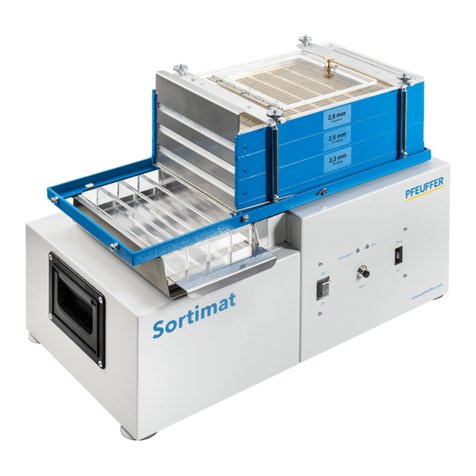
Operating Instructions MILOMAT laboratory mill
© 2017 Pfeuffer GmbH Revision 1 Page 3 of 32
Table of contents
1 Introduction............................................................................................................................... 4
1.1 Intendend use ........................................................................................................................................... 4
1.2 Declaration of conformity ......................................................................................................................... 5
1.3 Design characteristics of hazard warnings ................................................................................................ 6
1.4 Pictograms in the Operating Instructions ................................................................................................. 6
1.5 Abbreviations in electrical engineering..................................................................................................... 7
1.6 Designation................................................................................................................................................ 7
2 Safety ........................................................................................................................................ 8
2.1 Installed safety systems ............................................................................................................................ 8
2.1.1 Mains disconnector in a portable device .................................................................................... 8
2.1.2 Protective covers......................................................................................................................... 8
2.1.3 Safety switch ............................................................................................................................... 9
2.2 Operating and danger areas...................................................................................................................... 9
2.3 Operating and maintenance personnel................................................................................................... 10
2.4 Safety measures (to be carried out by the owner) ................................................................................. 10
2.5 General safety notes ............................................................................................................................... 11
2.6 Safety tests .............................................................................................................................................. 12
2.7 Residual dangers in connection with the MILOMAT ............................................................................... 12
2.8 Switch-off procedure............................................................................................................................... 12
3 Technical data.......................................................................................................................... 13
3.1 Dimensions and weight ........................................................................................................................... 13
3.2Power supply........................................................................................................................................... 13
3.3 General data............................................................................................................................................ 13
4 Delivery, transport and storage ................................................................................................ 14
4.1 Scope of delivery ..................................................................................................................................... 14
4.2 Transport and packaging......................................................................................................................... 14
4.3 Intermediate storage............................................................................................................................... 14
4.4 Transport to the installation site (by the customer) ............................................................................... 15
5 Installation and commissioning ................................................................................................ 15
5.1 Installation............................................................................................................................................... 15
6 Function .................................................................................................................................. 16
6.1 Overview ................................................................................................................................................. 16
6.2 Sequence of functions............................................................................................................................. 16
7 Operation ................................................................................................................................ 17
7.1 Sample preparation................................................................................................................................. 17
7.2Carrying out a milling process ................................................................................................................. 17
7.3 Milling process of inhomogeneous milling material with a sample dividing cup (option)...................... 20
8 Maintenance and cleaning........................................................................................................ 21
8.1 Cleaning................................................................................................................................................... 21
8.1.1 Renewing the air filter............................................................................................................... 22
8.2 Inspection interval and function test ...................................................................................................... 22
8.3 Working inside the housing..................................................................................................................... 22
8.3.1 Tools and equipment ................................................................................................................ 23
8.4Opening the housing ............................................................................................................................... 23
8.5 Changing the V-belt................................................................................................................................. 26
8.6 Changing the impact wheel..................................................................................................................... 28
8.7 Changing the outlet................................................................................................................................. 29
8.8 Checks ..................................................................................................................................................... 29
9 Malfunctions – causes and rectification .................................................................................... 30
10 Spare parts and accessories...................................................................................................... 31
11 Emergency ............................................................................................................................... 32
12 Dismantling and disposal.......................................................................................................... 32





























